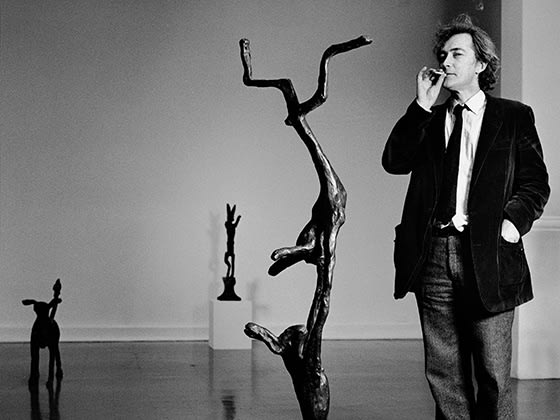Barry Flanagan
-
 Barry FlanaganHell's Bells, 2005Bronze, steel95 1/2 x 86 5/8 x 26 3/8 inchesFrom the edition of 8, plus three artist’s castsSold
Barry FlanaganHell's Bells, 2005Bronze, steel95 1/2 x 86 5/8 x 26 3/8 inchesFrom the edition of 8, plus three artist’s castsSold -
 Barry FlanaganLarger Thinker on Computer, 2003Bronze
Barry FlanaganLarger Thinker on Computer, 2003Bronze
83 ⅜ x 51 ½ x 44 ½ in
213 x 131 x 113 cm
Cast number 1 from an edition of 8 plus 3 ACsSold -
 Barry FlanaganLantern 1, 1994Bronze24 5/8 by 9 3/8 by 11 5/8 inchesCast number 6 from an edition of 8 plus artist's castsSold
Barry FlanaganLantern 1, 1994Bronze24 5/8 by 9 3/8 by 11 5/8 inchesCast number 6 from an edition of 8 plus artist's castsSold
Barry Flanagan (1941–2009) was born in North Wales and studied at St. Martin’s School of Art, later teaching there and at the Central School of Art. Early in his career, Flanagan revolutionized sculpture with his use of unconventional materials like sand, rope, and cloth, creating playful, radical works that challenged traditional forms. Influenced by ‘pataphysics, he often allowed materials to shape themselves, and his work reflected humor and poetic experimentation.
In the 1980s, Flanagan began creating the bronze hares for which he is best known—lively, monumental figures that merge the mythical, symbolic, and everyday, reflecting on human existence and our connection to the animal world. His use of the hare was inspired by seeing one run across the Sussex Downs, linking to Egyptian and Chinese mythologies around life and immortality. Flanagan also explored other animal forms, including horses and elephants, combining classical sculpture references with a contemporary sensibility.
Flanagan exhibited widely, participating in landmark shows such as When Attitudes Become Form (1969) and Informationat MoMA (1970), and held major exhibitions at institutions including the Tate and the Royal Academy. His work in film, performance, and collaboration—such as with Yoko Ono—further reflected his experimental approach. Elected a Royal Academician in 1991 and awarded an OBE, Flanagan remains celebrated for his innovative, spirited contribution to contemporary sculpture.
-

BARRY FLANAGAN Sculpting the Ephemeral
The Brooklyn Rail Read more -

Rediscovered at Tate Liverpool after more than 50 years, Barry Flanagan's 'the works' will soon go on show in London
The long-lost film, which was found during renovation works, will be turned into a performance in a Georgian house during Frieze week 27 September 2024 Read more





